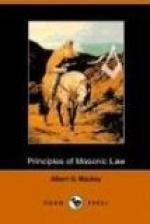This instrument differs from a dispensation in many important particulars. It is signed by all the Grand Officers, and emanates from the Grand Lodge, while the dispensation emanates from the office of the Grand Master, and is signed by him alone. The authority of the dispensation is temporary, that of the warrant permanent; the one can be revoked at pleasure by the Grand Master, who granted it; the other only for cause shown, and by the Grand Lodge; the one bestows only a name, the other both a name and a number; the one confers only the power of holding a lodge and making Masons, the other not only confers these powers, but also those of installation and of succession in office. From these differences in the characters of the two documents, arise important differences in the powers and privileges of a lodge under dispensation and of one that has been regularly constituted. These differences shall hereafter be considered.
The warrant having been granted, there still remain certain forms and ceremonies to be observed, before the lodge can take its place among the legal and registered lodges of the jurisdiction in which it is situated. These are its consecration, its dedication, its constitution, and the installation of its officers. We shall not fully enter into a description of these various ceremonies, because they are laid down at length in all the Monitors, and are readily accessible to our readers. It will be sufficient if we barely allude to their character.
The ceremony of constitution is so called, because by it the lodge becomes constituted or established. Orthoepists define the verb to constitute, as signifying “to give a formal existence to anything.” Hence, to constitute a lodge is to give it existence, character, and standing as such; and the instrument that warrants the person so constituting or establishing it, in this act, is very properly called the “warrant of constitution.”
The consecration, dedication, and constitution of a lodge must be performed by the Grand Master in person; or, if he cannot conveniently attend, by some Past Master appointed by him as his special proxy or representative for that purpose. On the appointed evening, the Grand Master, accompanied by his Grand Officers, repairs to the place where the new lodge is to hold its meetings, the lodge[29] having been placed in the centre of the room and decently covered with a piece of white linen or satin. Having taken the chair, he examines the records of the lodge and the warrant of constitution; the officers who have been chosen are presented before him, when he inquires of the Brethren if they continue satisfied with the choice they have made. The ceremony of consecration is then performed. The Lodge is uncovered; and corn, wine, and oil—the masonic elements of consecration—are poured upon it, accompanied by appropriate prayers and invocations, and the lodge is finally declared to be consecrated to the honor and glory of God.




